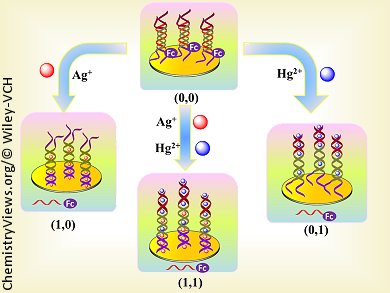Elementary logic gates are capable of performing Boolean logic by receiving one or more inputs and producing a single output; they are key components of electronic integrated circuits, such as those found in computers. Because nucleic acids exhibit many advantages that would rival silicon-based computation, the design of addressable DNA logic gates is at the center of significant research efforts to construct biologically relevant computation systems.
Jian-Ding Qiu and his team, Nanchang University, China, have reported on the development of a series of new metal-ion-mediated DNA logic gates (AND, NAND, and NOR) based on electrochemical outputs. These gates rely on the ability of Ag+ ions to specifically interact with cytosine–cytosine mismatches and of Hg+ ions to specifically interact with thymine–thymine mismatches in DNA duplexes, thus forming the inputs into the logic gates. Detection of the output is based on the change in Faradaic current from the attached redox reporter.
It is envisioned that the present strategy can be used to develop a series of electronic logic gates, which will pave the way for the development of multiplexed point-of-care sensing devices for metal ions.
- DNA Electronic Logic Gates Based on Metal-Ions-Dependent Induction of Oligonucleotide Structural Motifs,
Y.-M. Zhang, L. Zhang, R.-P. Liang, J.-D. Qiu,
Chem. Eur. J. 2013.
DOI: 10.1002/chem.201300625




